Liliane Momeni
Lost in Translation, Found in Context: Sign Language Translation with Contextual Cues
Jan 16, 2025



Abstract:Our objective is to translate continuous sign language into spoken language text. Inspired by the way human interpreters rely on context for accurate translation, we incorporate additional contextual cues together with the signing video, into a new translation framework. Specifically, besides visual sign recognition features that encode the input video, we integrate complementary textual information from (i) captions describing the background show, (ii) translation of previous sentences, as well as (iii) pseudo-glosses transcribing the signing. These are automatically extracted and inputted along with the visual features to a pre-trained large language model (LLM), which we fine-tune to generate spoken language translations in text form. Through extensive ablation studies, we show the positive contribution of each input cue to the translation performance. We train and evaluate our approach on BOBSL -- the largest British Sign Language dataset currently available. We show that our contextual approach significantly enhances the quality of the translations compared to previously reported results on BOBSL, and also to state-of-the-art methods that we implement as baselines. Furthermore, we demonstrate the generality of our approach by applying it also to How2Sign, an American Sign Language dataset, and achieve competitive results.
A Tale of Two Languages: Large-Vocabulary Continuous Sign Language Recognition from Spoken Language Supervision
May 16, 2024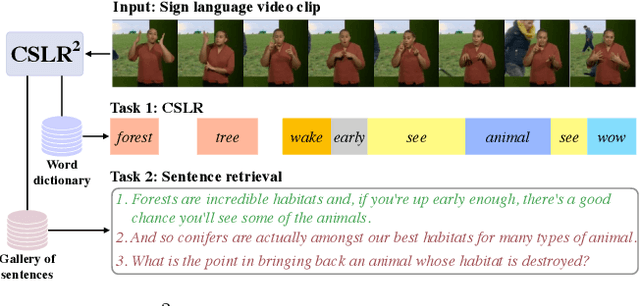

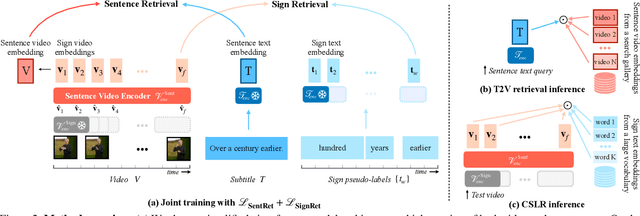

Abstract:In this work, our goals are two fold: large-vocabulary continuous sign language recognition (CSLR), and sign language retrieval. To this end, we introduce a multi-task Transformer model, CSLR2, that is able to ingest a signing sequence and output in a joint embedding space between signed language and spoken language text. To enable CSLR evaluation in the large-vocabulary setting, we introduce new dataset annotations that have been manually collected. These provide continuous sign-level annotations for six hours of test videos, and will be made publicly available. We demonstrate that by a careful choice of loss functions, training the model for both the CSLR and retrieval tasks is mutually beneficial in terms of performance -- retrieval improves CSLR performance by providing context, while CSLR improves retrieval with more fine-grained supervision. We further show the benefits of leveraging weak and noisy supervision from large-vocabulary datasets such as BOBSL, namely sign-level pseudo-labels, and English subtitles. Our model significantly outperforms the previous state of the art on both tasks.
Verbs in Action: Improving verb understanding in video-language models
Apr 13, 2023
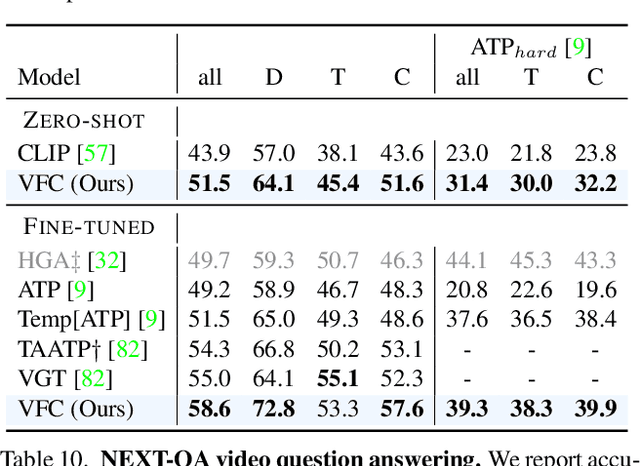
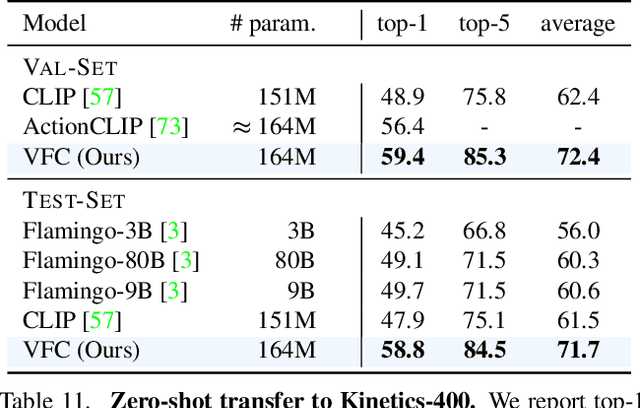
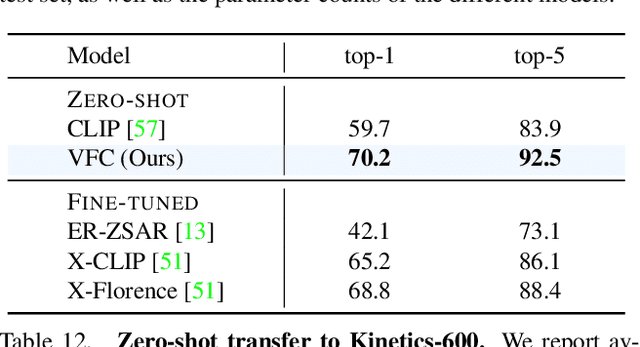
Abstract:Understanding verbs is crucial to modelling how people and objects interact with each other and the environment through space and time. Recently, state-of-the-art video-language models based on CLIP have been shown to have limited verb understanding and to rely extensively on nouns, restricting their performance in real-world video applications that require action and temporal understanding. In this work, we improve verb understanding for CLIP-based video-language models by proposing a new Verb-Focused Contrastive (VFC) framework. This consists of two main components: (1) leveraging pretrained large language models (LLMs) to create hard negatives for cross-modal contrastive learning, together with a calibration strategy to balance the occurrence of concepts in positive and negative pairs; and (2) enforcing a fine-grained, verb phrase alignment loss. Our method achieves state-of-the-art results for zero-shot performance on three downstream tasks that focus on verb understanding: video-text matching, video question-answering and video classification. To the best of our knowledge, this is the first work which proposes a method to alleviate the verb understanding problem, and does not simply highlight it.
Large Language Models are Few-shot Publication Scoopers
Apr 02, 2023Abstract:Driven by recent advances AI, we passengers are entering a golden age of scientific discovery. But golden for whom? Confronting our insecurity that others may beat us to the most acclaimed breakthroughs of the era, we propose a novel solution to the long-standing personal credit assignment problem to ensure that it is golden for us. At the heart of our approach is a pip-to-the-post algorithm that assures adulatory Wikipedia pages without incurring the substantial capital and career risks of pursuing high impact science with conventional research methodologies. By leveraging the meta trend of leveraging large language models for everything, we demonstrate the unparalleled potential of our algorithm to scoop groundbreaking findings with the insouciance of a seasoned researcher at a dessert buffet.
Weakly-supervised Fingerspelling Recognition in British Sign Language Videos
Nov 16, 2022



Abstract:The goal of this work is to detect and recognize sequences of letters signed using fingerspelling in British Sign Language (BSL). Previous fingerspelling recognition methods have not focused on BSL, which has a very different signing alphabet (e.g., two-handed instead of one-handed) to American Sign Language (ASL). They also use manual annotations for training. In contrast to previous methods, our method only uses weak annotations from subtitles for training. We localize potential instances of fingerspelling using a simple feature similarity method, then automatically annotate these instances by querying subtitle words and searching for corresponding mouthing cues from the signer. We propose a Transformer architecture adapted to this task, with a multiple-hypothesis CTC loss function to learn from alternative annotation possibilities. We employ a multi-stage training approach, where we make use of an initial version of our trained model to extend and enhance our training data before re-training again to achieve better performance. Through extensive evaluations, we verify our method for automatic annotation and our model architecture. Moreover, we provide a human expert annotated test set of 5K video clips for evaluating BSL fingerspelling recognition methods to support sign language research.
Automatic dense annotation of large-vocabulary sign language videos
Aug 04, 2022

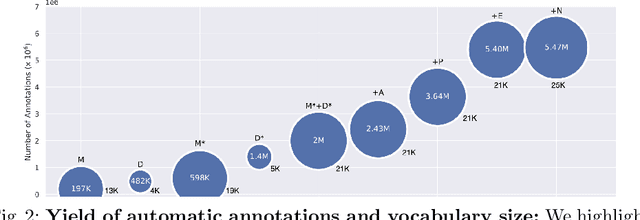
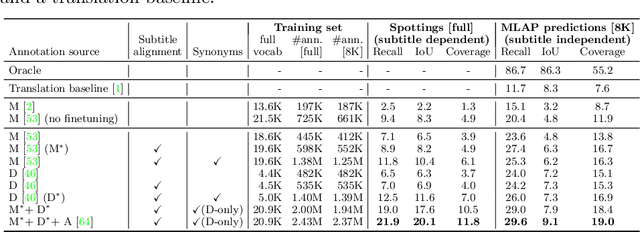
Abstract:Recently, sign language researchers have turned to sign language interpreted TV broadcasts, comprising (i) a video of continuous signing and (ii) subtitles corresponding to the audio content, as a readily available and large-scale source of training data. One key challenge in the usability of such data is the lack of sign annotations. Previous work exploiting such weakly-aligned data only found sparse correspondences between keywords in the subtitle and individual signs. In this work, we propose a simple, scalable framework to vastly increase the density of automatic annotations. Our contributions are the following: (1) we significantly improve previous annotation methods by making use of synonyms and subtitle-signing alignment; (2) we show the value of pseudo-labelling from a sign recognition model as a way of sign spotting; (3) we propose a novel approach for increasing our annotations of known and unknown classes based on in-domain exemplars; (4) on the BOBSL BSL sign language corpus, we increase the number of confident automatic annotations from 670K to 5M. We make these annotations publicly available to support the sign language research community.
Scaling up sign spotting through sign language dictionaries
May 09, 2022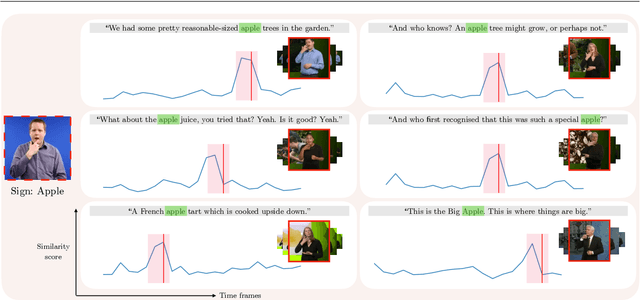

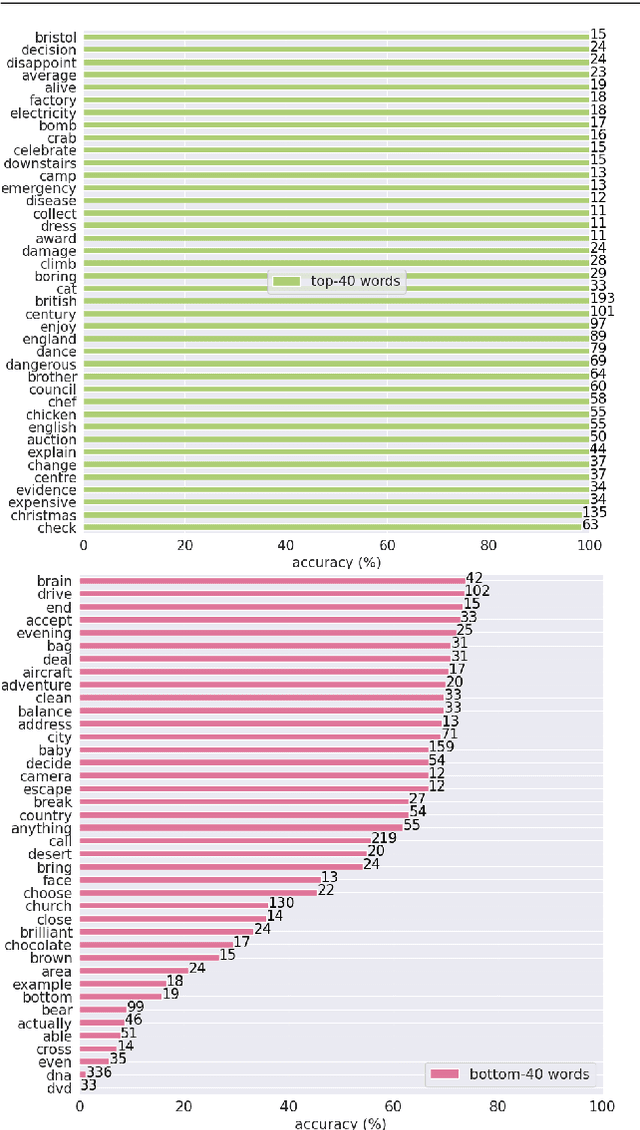
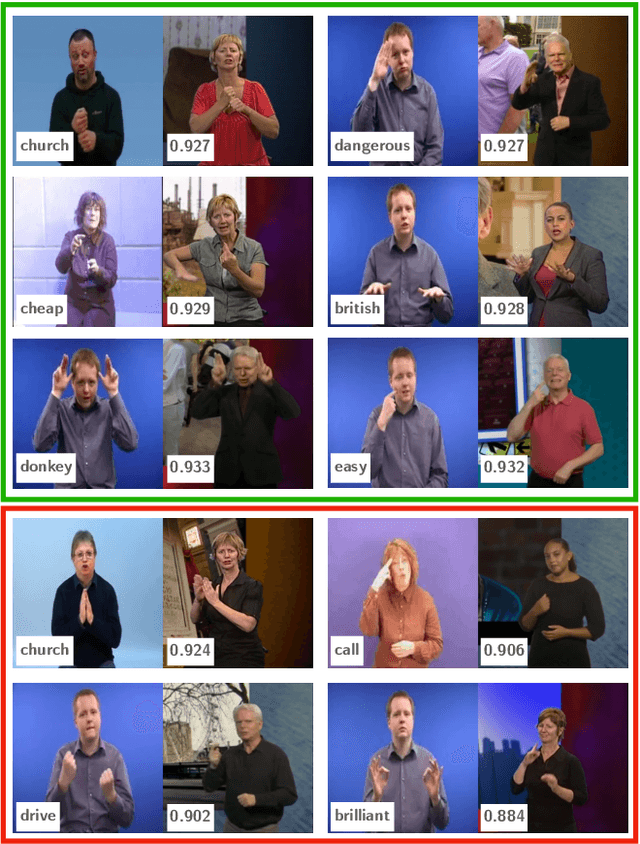
Abstract:The focus of this work is $\textit{sign spotting}$ - given a video of an isolated sign, our task is to identify $\textit{whether}$ and $\textit{where}$ it has been signed in a continuous, co-articulated sign language video. To achieve this sign spotting task, we train a model using multiple types of available supervision by: (1) $\textit{watching}$ existing footage which is sparsely labelled using mouthing cues; (2) $\textit{reading}$ associated subtitles (readily available translations of the signed content) which provide additional $\textit{weak-supervision}$; (3) $\textit{looking up}$ words (for which no co-articulated labelled examples are available) in visual sign language dictionaries to enable novel sign spotting. These three tasks are integrated into a unified learning framework using the principles of Noise Contrastive Estimation and Multiple Instance Learning. We validate the effectiveness of our approach on low-shot sign spotting benchmarks. In addition, we contribute a machine-readable British Sign Language (BSL) dictionary dataset of isolated signs, BSLDict, to facilitate study of this task. The dataset, models and code are available at our project page.
* Appears in: 2022 International Journal of Computer Vision (IJCV). 25 pages. arXiv admin note: substantial text overlap with arXiv:2010.04002
BBC-Oxford British Sign Language Dataset
Nov 05, 2021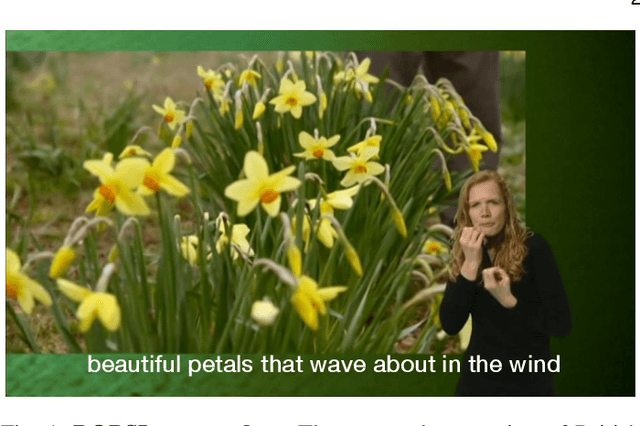


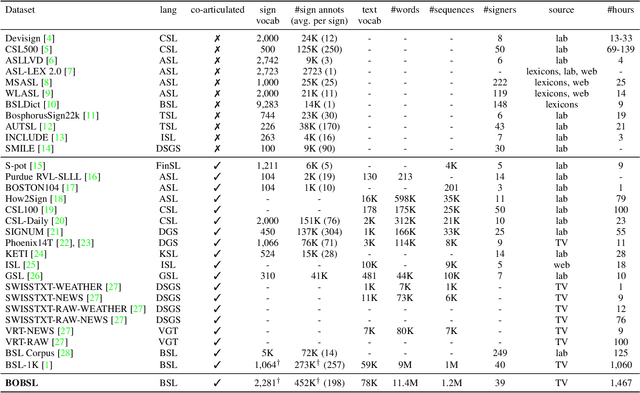
Abstract:In this work, we introduce the BBC-Oxford British Sign Language (BOBSL) dataset, a large-scale video collection of British Sign Language (BSL). BOBSL is an extended and publicly released dataset based on the BSL-1K dataset introduced in previous work. We describe the motivation for the dataset, together with statistics and available annotations. We conduct experiments to provide baselines for the tasks of sign recognition, sign language alignment, and sign language translation. Finally, we describe several strengths and limitations of the data from the perspectives of machine learning and linguistics, note sources of bias present in the dataset, and discuss potential applications of BOBSL in the context of sign language technology. The dataset is available at https://www.robots.ox.ac.uk/~vgg/data/bobsl/.
Visual Keyword Spotting with Attention
Oct 29, 2021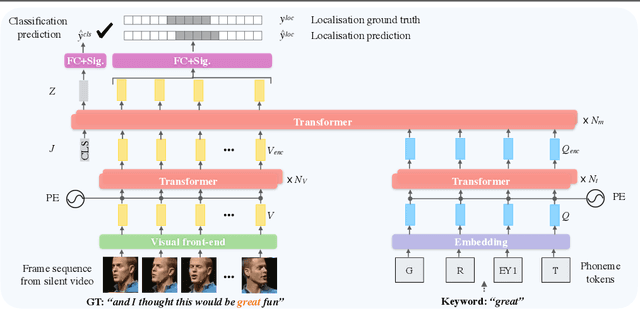



Abstract:In this paper, we consider the task of spotting spoken keywords in silent video sequences -- also known as visual keyword spotting. To this end, we investigate Transformer-based models that ingest two streams, a visual encoding of the video and a phonetic encoding of the keyword, and output the temporal location of the keyword if present. Our contributions are as follows: (1) We propose a novel architecture, the Transpotter, that uses full cross-modal attention between the visual and phonetic streams; (2) We show through extensive evaluations that our model outperforms the prior state-of-the-art visual keyword spotting and lip reading methods on the challenging LRW, LRS2, LRS3 datasets by a large margin; (3) We demonstrate the ability of our model to spot words under the extreme conditions of isolated mouthings in sign language videos.
Aligning Subtitles in Sign Language Videos
May 06, 2021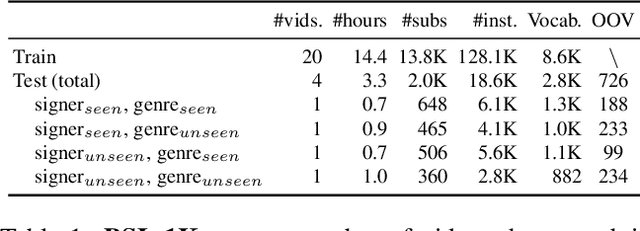
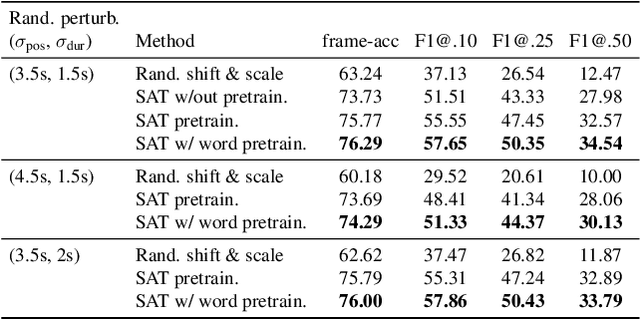


Abstract:The goal of this work is to temporally align asynchronous subtitles in sign language videos. In particular, we focus on sign-language interpreted TV broadcast data comprising (i) a video of continuous signing, and (ii) subtitles corresponding to the audio content. Previous work exploiting such weakly-aligned data only considered finding keyword-sign correspondences, whereas we aim to localise a complete subtitle text in continuous signing. We propose a Transformer architecture tailored for this task, which we train on manually annotated alignments covering over 15K subtitles that span 17.7 hours of video. We use BERT subtitle embeddings and CNN video representations learned for sign recognition to encode the two signals, which interact through a series of attention layers. Our model outputs frame-level predictions, i.e., for each video frame, whether it belongs to the queried subtitle or not. Through extensive evaluations, we show substantial improvements over existing alignment baselines that do not make use of subtitle text embeddings for learning. Our automatic alignment model opens up possibilities for advancing machine translation of sign languages via providing continuously synchronized video-text data.
 Add to Chrome
Add to Chrome Add to Firefox
Add to Firefox Add to Edge
Add to Edge